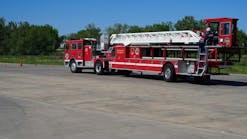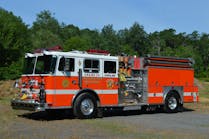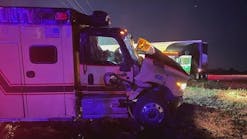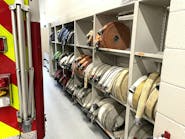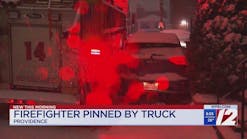The November installment of The Apparatus Architect series discussed the merits of applying guidelines when setting out to develop specifications for new fire apparatus. Discerning readers may have thought, “Hey, these are just common sense,” and moved on to read another article. We can assure you that during our careers we have encountered departments where common sense was not so common and the results were predictable.
Recently, we received an inquiry from a department that had placed a new mini-rescue truck into service. After the unit was outfitted, several members complained of poor handling and braking performance. An investigation led to the decision to weigh the vehicle. The result: the truck was overloaded on the rear axle by a wide margin. Further review found a weight-analysis calculation submitted as a part of the successful bidder’s proposal indicating that there would sufficient payload capacity on the rescue truck in accordance with Table 12.1.2 of the National Fire Protection Association (NFPA) 1901: Standard for Automotive Fire Apparatus.
While the mini-rescue truck had been placed into service for some time, because the fire department requested a weight study with its specifications, this provided the needed legal recourse to show that the manufacturer’s original weight study was inaccurate and in fact the rescue truck could not carry the department’s equipment inventory, even though it was less than the minimum payload called for within NFPA 1901.
Many apparatus issues and deficiencies that are identified after delivery and payment do not have pleasant endings or require a great deal of effort to resolve in a satisfactory manner. Specification development is a technical skill. Requirements that are legal and written to favor the interests of the fire department and purchasing authority are important factors in the process.
GUIDELINE 8
Match the design capabilities of the apparatus to your staffing and deployment practices
Many departments attempt to solve staffing problems by buying combination units. However, many combination units that we have seen are too high, too long, overweight and too large to maneuver safely around first-due response areas. Some departments are designing apparatus that have a little of everything, but when they reach the fireground, they are not very good at anything.
A common theme is cited by some departments that combined a heavy rescue with an engine apparatus into a single rescue engine. After the unit is placed into service, and while everyone will agree that the manufacturer built exactly what the department asked for, it turns out that the rig is neither a good engine nor a good rescue. The result is that some departments are trying to provide more services with less staffing and it is easy to specify a combination apparatus thinking that firefighters will bring all the tools in one box and hope for the best.
If you have a staffing problem, then work to solve the staffing problem. Do not try to design a one-size-fits-all fire apparatus to solve a staffing problem.
GUIDELINE 9
Be wary of requirements for down payments or deposits on apparatus at the time of contract signing
Let’s be frank, building fire apparatus is a material- and labor-intensive process that requires manufacturers to front a considerable amount of money to engineer and build a single apparatus while waiting for delivery and acceptance before recouping any of that money. Major builders have to maintain large lines of credit with financial institutions in order to produce apparatus on a regular basis. If your department can secure a financial incentive to lower the cost of the vehicle, then certainly this must be investigated, but with due caution.
At the time of the bid, request a Dun & Bradstreet financial report from each bidder to assess its financial stability. Do not make any payments without having the security of a performance bond and being able to take ownership of chassis or other major components that clearly can be tracked and identified for use on your new vehicle.
This concept coincides with Guideline 7, where the fire department and the successful bidder should clearly understand the testing and acceptance criteria that will lead to payment for the apparatus once it is delivered to the fire station.
GUIDELINE 10
Be mindful of overall vehicle size, including wheelbase, turning radius, overall length and height
This sounds almost too simple; however, it is frequently overlooked. Make sure the vehicle will fit into your station and anyplace else where is could be housed, even as a transfer company, a relocation company or a standby company. Before specifying vehicle components, measure the apparatus bay in all configurations, tour the response district and confirm bridge clearances and other impediments that could impact apparatus placement.
Several departments, in an effort to gain compartment space, determined that a hydraulic ladder rack would move the ladders to an upper position on the body and allow space for full-height compartments on the right side of the unit. While they gained the desired compartment space, the ladder rack proved to not work on streets with parked cars on both sides as well as in private apartment complexes.
Ask each bidder to submit a turning radius report with its proposal to show the left and right cramp angles and curb-to-curb and wall-to-wall turning radius. This documentation will provide the information needed to determine whether the vehicle will maneuver within areas of your response district. Along the way, the apparatus committee should have a similar apparatus brought for inspection and be permitted to drive the unit in all areas of concern to confirm that the apparatus will perform as expected.
GUIDELINE 11
Get help if you are unsure, stuck or otherwise confused
There are numerous ways for the apparatus committee to secure guidance and technical information, including trade shows, manufacturers’ websites, reading other departments’ procurement documents and sales personnel. Each of these resources should be investigated to provide valuable knowledge through the specification development process.
Many departments have either their own mechanics or use outside vendors that can provide specific recommendations of components that have good track records and increase the reliability and in service time for the apparatus. A visit to any fire apparatus repair shop can provide invaluable information on what works and is practical to improve the operational safety and efficiency of an apparatus fleet.
Following each of these 11 guidelines should provide a basis for a positive apparatus specification and procurement process. Unlike a buffet meal, you cannot pick and choose which of these guidelines to follow and disregard the rest.
Our experience in assisting fire departments with all sizes of apparatus fleets has proven that once you set out to acquire a new vehicle, the process must be planned to address many of the simple and difficult questions that will arise during the process. Time spent in the initial stages of the specification development will pay dividends in the end with a well-designed apparatus that meets everyone’s expectations.
Tom Shand and Michael Wilbur present “Apparatus Innovations: Past, Present and Future” at Firehouse World 2015. Also, Wilbur presents “What Have We Learned?” and Shand presents “Multipurpose Apparatus: How to Design and Package Your Personnel and Equipment.”
TOM SHAND, a Firehouse® contributing editor, is a 37-year veteran of the fire service and works with Michael Wilbur at Emergency Vehicle Response, consulting on a variety of fire apparatus and fire department master-planning issues. MICHAEL WILBUR, a Firehouse® contributing editor, recently retired as a lieutenant in the New York City Fire Department, where he was last assigned to Ladder Company 27 in the Bronx. He has served on the FDNY Apparatus Purchasing Committee and consults on a variety of apparatus-related issues around the country.
Connect with Mike
Website: emergencyvehicleresponse.com
Facebook: LINK TO COME
Twitter: LINK TO COME
LinkedIn: LINK TO COME
Connect with Tom
Facebook: https://www.facebook.com/tom.shand.775

